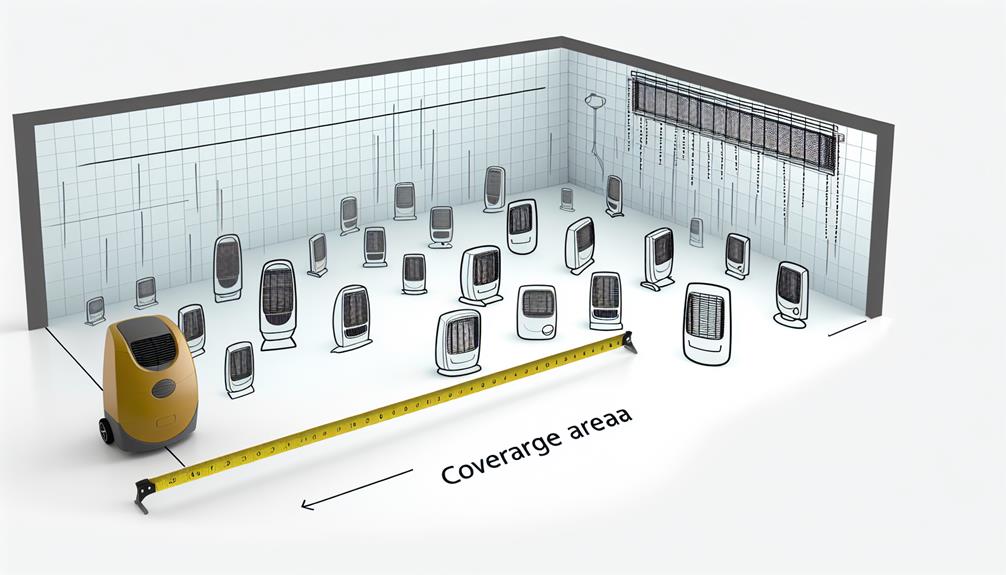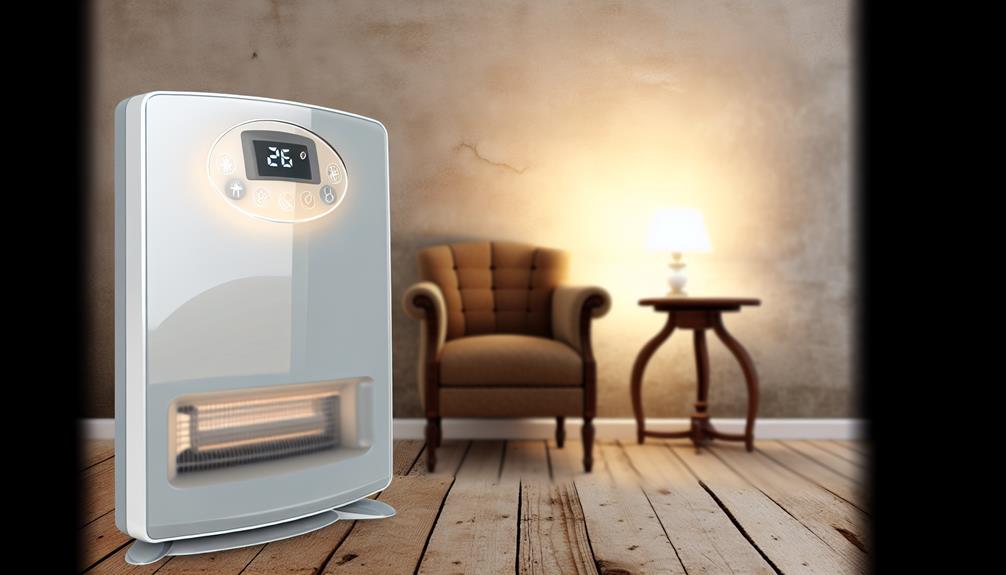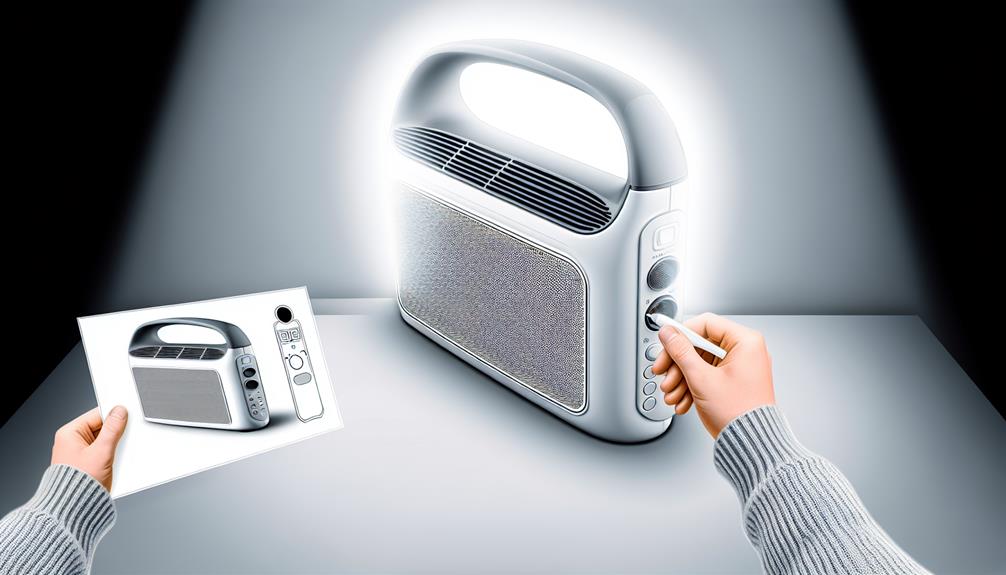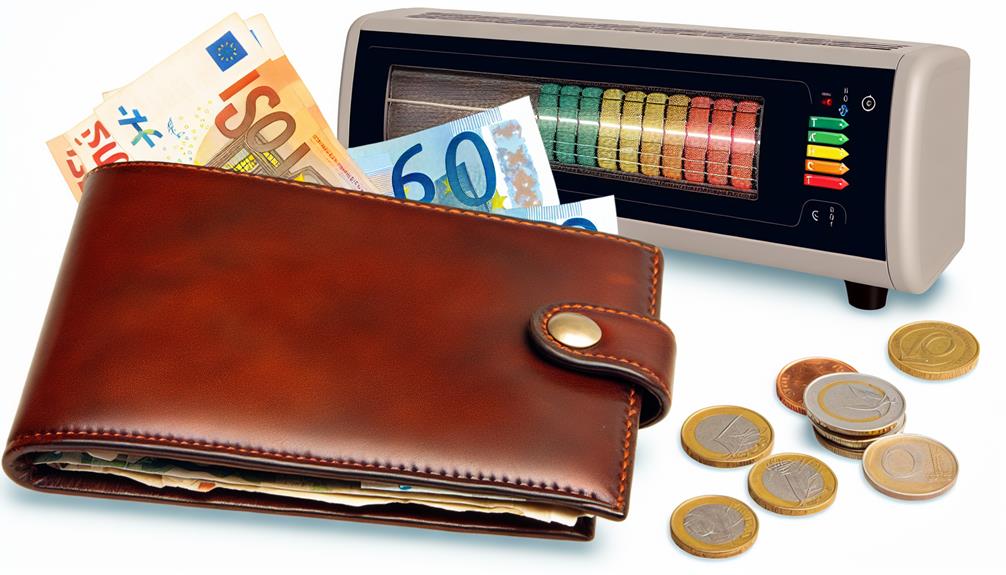As you enter the market for a new portable heater, you're faced with a landscape of options that can warm up your decision-making process. You'll want to consider the heater's capacity to ensure it's adequate for your space without being overkill—after all, you don't want to fire up a power plant for a cozy room. Think about the type of heater that aligns with your comfort preferences and the specific quirks of the area you're looking to heat. Safety can't be an afterthought; it's paramount to choose a model that boasts reliable safety features to keep you and your loved ones secure. And let's not overlook efficiency and operating costs, which can make or break your budget over the long, chilly months. You're on the brink of making an informed choice, and there are a few more nuggets of wisdom that could tip the scales in favor of the perfect portable heater for your needs. Stay tuned to ensure you're equipped with all the essentials before taking the plunge.
Key Takeaways
- Consider the type of heating technology that best suits your needs, such as convection, radiant, fan-forced, wall, or portable heaters.
- Look for energy-efficient heaters with lower wattage or BTU ratings to conserve energy and reduce electricity bills.
- Calculate the necessary wattage or BTUs based on the size of the room to ensure adequate heating coverage.
- Prioritize safety features such as overheat protection, tip-over switch, cool-to-the-touch exteriors, and safety certifications from recognized testing laboratories.
Heater Type Variations
When choosing a portable heater, it's crucial to understand the different types available, each with its distinct method of heating and suitability for various spaces. Electric space heaters, one of the most common types of space heaters, offer a range of heating technologies tailored to your needs.
Convection heaters are ideal for quiet, whole-room heating. Their design allows for the natural circulation of warm air, effectively maintaining a consistent temperature throughout a space. This makes them an excellent choice for sustained supplemental heating in well-insulated areas.
Radiant or infrared heaters, on the other hand, deliver rapid warmth by directly heating objects and people in their path through radiant heat. They're perfect when you need immediate heat without waiting for the entire room to warm up.
Fan-forced heaters use fans to blow heated air across a room, ensuring quicker and more even distribution of heat. They work well in spaces where you require fast heating and don't mind a bit of background noise.
For a more permanent solution, wall heaters can address under-heated rooms with a fixed heating capacity. However, if you're seeking a heater specifically for flexibility and convenience, portable heaters allow for easy relocation to target areas needing supplemental heating. Consider these options to find the best fit for your heating needs and room layout.
Energy Efficiency Ratings
Understanding the energy efficiency ratings of portable heaters is crucial, as it directly influences your heater's energy consumption and the cost of operation. When you're in the market for a portable heater, considering the watts of heating power is essential. This figure tells you the amount of energy the heater uses to operate. An energy-efficient model can help you save energy, and consequently, money over time.
Here are key points to keep in mind:
- Wattage: Lower wattage heaters use less energy, which can conserve energy and reduce your electricity bills.
- Room Size: Choose a heater with a wattage appropriate for the size of your room to ensure energy efficient heating.
- British Thermal Unit (BTU): Some heaters use BTUs to measure heating power; compare these to find an energy-efficient option.
- Heater Type: The type of space heater you select can impact energy usage; some heaters will warm up a room using less energy than others.
Size and Coverage Area

Selecting a portable heater with the correct wattage or BTU rating is essential for effectively warming the intended space, whether it's a cozy nook or an expansive living area. You'll need to calculate the necessary wattage or BTUs based on the size of the room. Typically, a heater uses 10 watts of heating power to warm each square foot, so a 1500-watt heater can cover about 150 square feet of space.
Heaters come in a variety of sizes, and it's crucial to match the heater's coverage area with the size of the space you want to heat. For a smaller space, a heater with a lower wattage and square footage rating will provide direct heat without unnecessary energy consumption. Conversely, a larger space requires a heater with a higher rating to ensure whole room comfort.
Consider the following table for quick reference:
| Heater Size | Coverage Area |
|---|---|
| Small | Up to 150 sq ft |
| Medium | 150-250 sq ft |
| Large | 250+ sq ft |
Safety Features Checklist
While matching a heater's size to your room ensures effective heating, it's equally critical to prioritize safety by adhering to a comprehensive checklist of safety features. As you peruse the Space Heater Buying Guide and consider what heater to keep you warm, always factor in Heater Safety to prevent incidents that could create a fire.
Here's what to look for:
- Overheat Protection: This ensures the heater turns off automatically if it gets too hot.
- Tip-Over Switch: A crucial safety feature that cuts power if the heater is accidentally knocked over.
- Cool-to-the-Touch Exteriors: To minimize burn risks, especially in homes with children or pets.
- Safety Certifications: Opt for heaters tested and approved by a recognized testing laboratory, ensuring compliance with safety standards.
When using a space heater, it's vital to follow safety guidelines: place it on a hard, nonflammable surface, keep it away from combustibles, and never use an extension cord, as it can overheat. Additionally, maintain a safe distance from flammable substances and ensure the space is well-ventilated. Regular inspection and maintenance are key to safe operation. Always consider these safety features when buying to ensure your warmth doesn't come at a risk.
Temperature Control Options

To ensure comfort and efficiency in your space, opt for portable heaters equipped with adjustable thermostat settings that allow you to fine-tune the temperature to your exact preferences. When buying a space heater, consider the importance of a thermostat that can accurately gauge and adjust to maintain the room temperature you desire. This feature not only enhances comfort but can also help to lower heating costs by avoiding overuse of the heater.
It's essential to choose a heater with a range of heat settings, providing supplemental warmth precisely where and when you need it. A heater with a high degree of adjustability means you can raise the heat during colder times and lower it as the room reaches a comfortable level, without the need to use an extension cord or relocate the heater.
Moreover, selecting the right size heater is crucial for effective temperature control. A heater that's too small won't adequately heat your space, while one that's too large will consume excessive energy. A heater with a programmable timer and remote control can offer further convenience, enabling you to pre-set heating times and make adjustments remotely, ensuring your space is always at an ideal temperature.
Noise Level Considerations
When selecting a portable heater, you must consider the decibel (dB) ratings, which quantify the noise level produced by the unit. Quiet operation features, such as specially designed fan blades or noise-reducing insulation, are crucial for maintaining a peaceful environment. Assessing these factors ensures you choose a heater that won't disrupt your comfort with unwanted sound.
Decibel Ratings Explained
Understanding the decibel ratings of portable heaters is crucial, as they directly indicate how much noise the appliance will produce during operation. When buying a space heater, it's important to consider the following:
- Styles: Heaters with a blower fan tend to be louder than those using natural convection.
- Variety of Sizes: Larger models may produce more noise; decibel levels can guide your choice.
- Things to Consider: Ensure the decibel rating aligns with your intended use—lower for quiet environments like bedrooms.
- Best Space: Choose a heater with a decibel rating around 50dB for a peaceful experience in noise-sensitive areas.
Always make sure the noise level is compatible with your best space use, whether you're heating a bustling family room or a tranquil office.
Quiet Operation Features
Having explored how decibel ratings affect your choice of portable heaters, let's now examine the specific features that contribute to quiet operation and how they can enhance your environment. When selecting a space heater, consider fan-forced models which utilize a blower to distribute warm air throughout the room efficiently and quietly. Convection heaters are an excellent choice as well, gently circulating heated air without the need for extra noise.
User reviews are an indispensable resource for assessing the real-world performance of quiet operation features. Here's a quick reference to guide your selection:
| Heater Type | Quiet Operation Features |
|---|---|
| Fan-Forced Heater | Evenly distributes warm air |
| Convection Heater | Silent circulation of heated air |
| User Reviews | Real-world assessments |
| Noise Level | Low decibel rating |
For a personal space or when accommodating one or two people, prioritize heaters with a reputation for near-silent operation to maintain a peaceful atmosphere.
Portability and Design

As you evaluate portable heaters, pay close attention to the unit's size and weight, as these factors directly impact its ease of transportability and room-to-room mobility. Ensure that the model you choose has functional design features, such as handles or wheels, to enhance its convenience and reduce the effort required for movement. Additionally, the heater's aesthetics and design should not only be compact but also complement your living or working environment, offering flexible placement without compromising style.
Heater Size & Weight
When selecting a portable heater, it's essential to assess its size and weight to ensure it can be easily moved and stored in your intended space. Space heaters come in a variety of sizes and weights, and finding the right one can make a big difference in how you supplement your primary heat source.
- Compact Design: Look for a space heater that's small enough to fit where you plan to use it, without being a tripping hazard.
- Lightweight Build: Heaters are typically easier to move when they're lighter, allowing you to stay warm in any room.
- Handles and Wheels: These features add to the portability, making it simple to reposition your heater.
- Storage Features: Foldable or retractable components are a plus for saving space when the heater's not in use.
Design Aesthetics & Functionality
In choosing a portable heater, prioritize designs that not only facilitate effortless transport across your home but also enhance the aesthetic appeal of your living spaces. Look for space heaters that work well with your home's decor and offer functionality through features like a built-in fan to circulate warm air. Sleek, lightweight models with handles are ideal, as they quickly warm the room and are easy to move.
| Feature | Benefit |
|---|---|
| Design Aesthetics | Complements home decor, adds visual appeal |
| Functionality | Efficient heating element, retains heat well |
| Portability | Lightweight with power cord management, easy to carry |
| Heating Efficiency | Quick warm-up, fan to circulate heat evenly |
Heaters come in various designs, so select one that will not only heat your space but also reflect your personal style.
Mobility Features & Convenience
While considering the aesthetic and functional aspects of portable heaters, don't overlook the importance of mobility features and convenience for effortless relocation and storage. As you're evaluating space heaters, keep in mind that mobility features & convenience can significantly enhance your experience. Heaters come in a variety, each with different mobility solutions:
- Weight and Handles: Look for lightweight models with sturdy handles.
- Wheels and Design: Some heaters offer wheels for easy movement, particularly those with a heavier build like diathermic oil heaters.
- Cord Management: A space heater with cord storage or smart power cord placement is both economical and convenient.
- Compactness: Sleek, space-saving designs can fit in tight spaces and are easier to move around.
Cost and Additional Expenses

Before investing in a portable heater, it's important to assess not only its upfront cost but also the long-term expenses, such as energy consumption and maintenance requirements, to gauge its true financial impact. A thorough examination of these factors is crucial, especially when considering the variety of heaters available, such as a space heater or an industrial unit, as outlined in an industrial heater buying guide.
When calculating costs, consider the price per unit of heat produced and compare it across different models to determine which offers the best value. Keep your electric bill in mind; use different heaters with varying energy efficiencies to manage long-term expenses. Maintenance, such as replacing filters or parts, can add up, so factor these into your budget.
Moreover, be mindful of additional fees after your order, particularly if you're outside the free shipping zones. For instance, shipments to Canada may incur additional taxes and brokerage fees, and international shipments may incur duties. Check for promotions offering free shipping to the lower 48 states to mitigate some of these expenses.
| Expense Category | Considerations |
|---|---|
| Initial Purchase Cost | Shipping, taxes, discounts |
| Operating Costs | Energy efficiency, cost per kWh |
| Maintenance & Service | Warranty, replacement parts, labor fees |
Frequently Asked Questions
How Do I Choose a Portable Space Heater?
To choose a portable space heater, assess heater size against your room's dimensions and select one with a thermostat control for energy efficiency. Prioritize safety features, including overheat protection, and consider the noise level for comfort. Factor in heater placement and climate compatibility. Perform a cost analysis, not overlooking maintenance requirements. Lastly, research brand reputation to ensure reliability. This technical approach ensures you make an informed, detailed decision tailored to your needs.
What Should Be Considered When Using Portable Heaters?
Navigating the warmth maze of portable heaters, you'll want to ensure safety precautions top the list. Keep a keen eye on ventilation to avoid carbon monoxide risks. Seek out energy-efficient models to keep bills low and check for a whisper-quiet operation. Place your heater strategically, away from flammables, and adhere to maintenance tips. Long cords offer flexibility, while a precise thermostat and overheating protection are your guardians against the chill.
What Is the Best Wattage for a Portable Heater?
The best wattage for your portable heater depends on the room size and heating capacity needed. For energy efficiency, match wattage to space—generally 10 watts per square foot. Climate adaptability, safety features, noise levels, lifespan, aesthetic design, maintenance requirements, and cost analysis are crucial. A 1,500-watt heater fits a 150-square-foot room. Always prioritize safety certifications to avoid hazards. Consider these factors to make an informed decision.
What Is the Most Effective Type of Portable Heater?
You're seeking the most efficient portable heater, right? Well, infrared heaters excel in personal warmth with efficient halogen elements. Ceramic models leverage convection currents, balancing energy consumption and heating capacity. Oil-filled radiators are less about speed, more on maintaining temperature. For on-the-go, propane heaters offer unmatched portability. Whatever you choose, prioritize safety features to mitigate fire risks. Ultimately, your specific needs dictate which type—convection, radiant, or otherwise—suits you best.
